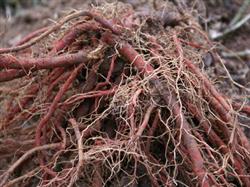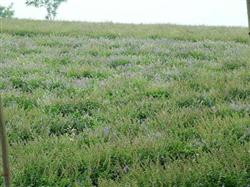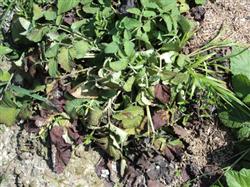How to control root-knot nematode disease of Salvia miltiorrhiza?

How to control root knot nematode disease? How does red sage root knot nematode disease have symptom? The control methods of root knot nematode disease of Salvia miltiorrhiza can be referred to as follows: I. Harmful symptoms This disease harms the roots of Salvia miltiorrhiza. The injured taproot, lateral root and fibrous root have tumor-shaped gall, the taproot and lateral root become thin, fibrous root become more. The gall has fine hair roots. After parasitizing nematodes, the root system function was destroyed, the plant was dwarfed obviously, the leaf color turned yellow, the growth was thin, and the yield was affected. II. Control methods 1. Rotation: rotation with gramineous crops for more than 3 years can reduce nematode density in soil. The longer the rotation period, the better the effect. Be careful not to rotate with the host plant of root knot nematode disease. 2. Chemical treatment: 1.5~ 2 kg of 3% Miler granules per mu, 50 kg of dry fine soil, applied to 20 cm of soil 10 days before sowing, and immediately covered with soil flattening. Can also be mu with 98% cotton (will speed out) granules 5~ 6 kg, add dry fine soil appropriate mix, in the sowing time into the sowing ditch. Click to get more Danshen planting technology Click to get more herbal planting technology
- Prev

How to manage planting Salvia miltiorrhiza?
How to manage planting Salvia miltiorrhiza? Please give introduction and guidance on the management of planting Salvia miltiorrhiza as follows: 1. It is usually carried out three times, the first in May, when the seedling height is about 15 cm, the second in June, and the third in August. 2. Topdressing at the right time. Topdressing combined with ploughing and weeding. Chase per mu.
- Next

How to prevent and cure root rot of Salvia miltiorrhiza?
How to prevent and cure root rot of Salvia miltiorrhiza? Please introduce Salvia miltiorrhiza root rot: first, harmful symptoms: Salvia miltiorrhiza root rot occurs in the high temperature and rainy season, harming the roots of the plant. At the initial stage, only a few roots or part of the underground rhizome became ill first, and gradually expanded to the whole root system. Wet rot occurs after the root is killed, and the skin is black.
Related
- Fuxing push coffee new agricultural production and marketing class: lack of small-scale processing plants
- Jujube rice field leisure farm deep ploughing Yilan for five years to create a space for organic food and play
- Nongyu Farm-A trial of organic papaya for brave women with advanced technology
- Four points for attention in the prevention and control of diseases and insect pests of edible fungi
- How to add nutrient solution to Edible Fungi
- Is there any good way to control edible fungus mites?
- Open Inoculation Technology of Edible Fungi
- Is there any clever way to use fertilizer for edible fungus in winter?
- What agents are used to kill the pathogens of edible fungi in the mushroom shed?
- Rapid drying of Edible Fungi

